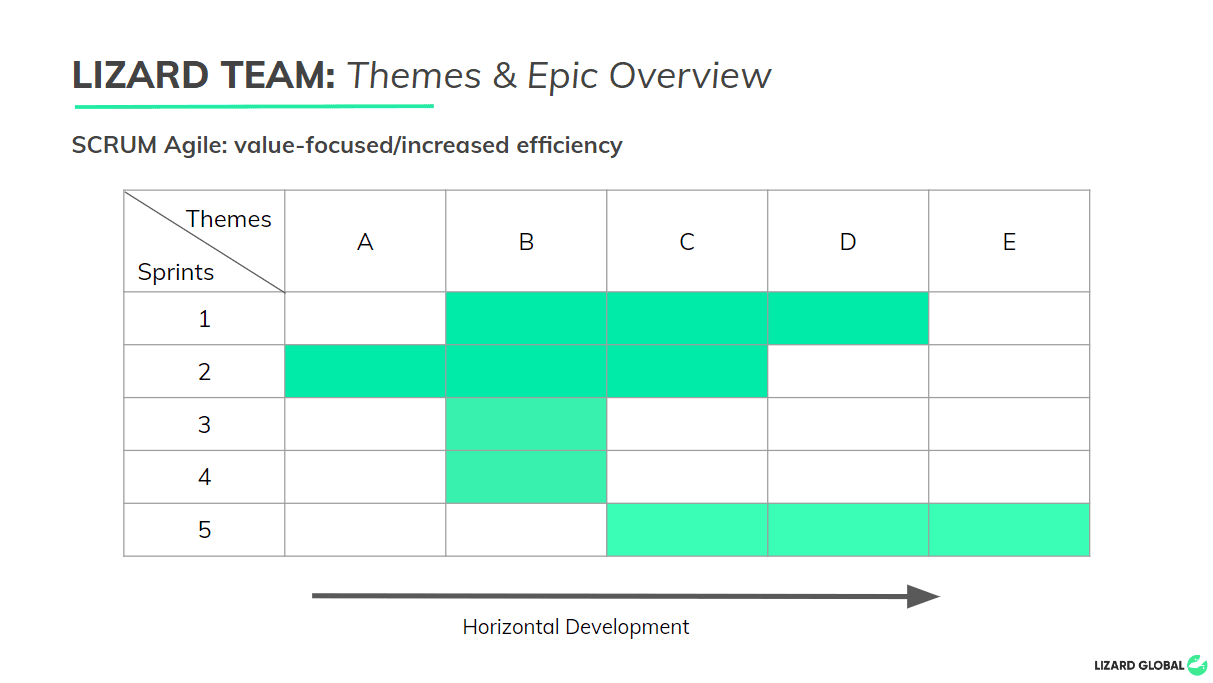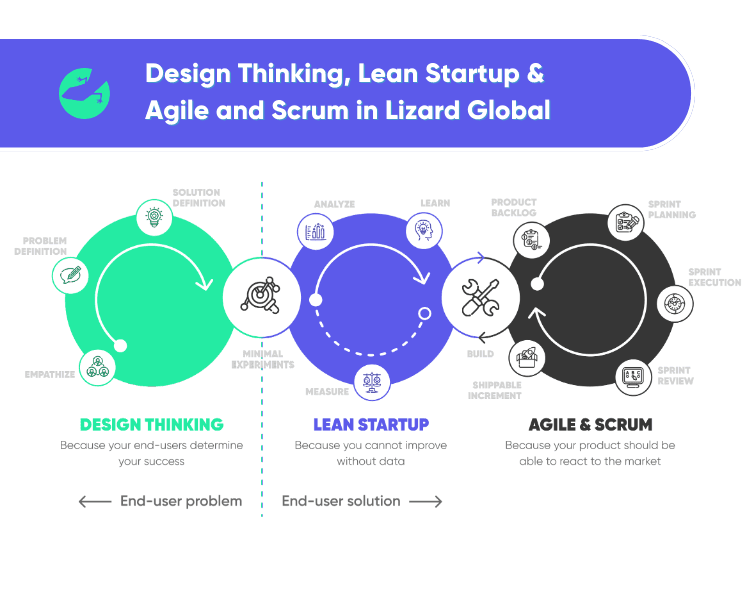Sprint Goal, What Is It and How to Come Up With One?
Get the latest updates about our blog posts.
Subscribe so you don’t miss out!
Follow Lizard Global on Facebook, Instagram, and LinkedIn.
The Sprint Goal functions as the focal point that brings transparency to the Sprint Backlog, the rallying point for the team, and the singular item that fosters teamwork and focus in Scrum. While most Scrum Masters understand the importance of Sprint Goals, there is a great deal of misunderstanding and discontent over the way they are created. Should you create the sprint goal before the sprint backlog? How can you make a Sprint Goal out of the seemingly unconnected items at the top of your Product Backlog? Without putting the Sprint Goal at the center of their activities, no Scrum team has ever been able to fully benefit from the framework.
With these pointers, learn how well-crafted sprint goals can improve alignment, foster buy-in across the board, and enhance your Agile development process.
We have explored the buzzwords in Scrum Master methodologies, such as Sprint Backlog, Sprint Planning and more, in this blog: The Scrum Sprint Up Close: What, Who, How?
What is a Sprint Goal in Scrum?
A sprint goal is a high-level, agreed-upon objective that outlines the primary result for every sprint that a Scrum team works on. The sprint goal informs the development team of the purpose of the current increment in the same manner that a product vision directs a product's longer-term course. It also discusses the benefits the sprint will provide to the Product Owner and why it is valuable to do.
For example, "the goal for this sprint is to deliver “Add Address” to the customer record." is not a smart way to summarize the sprint's best user story. It needs to be more in-depth than that, outlining the motivation behind the sprint and assisting the team in comprehending the significance and aim of their task.
Why are Sprint Goals important in Scrum?
A sprint aim usually focuses on one or more of the following:
- Testing presumptions on the complexity of development for a larger project
- Manage risks by making necessary adjustments, changing the architecture, or introducing new elements.
- Create fresh features and incorporate customer-requested new stories.
As these make or break a project, in the software development context, a Scrum Master should take sprint goals seriously as they:
- Facilitates the tracking and evaluation of sprint progress.
- Help the development team evaluate and monitor their progress concerning the sprint objective.
- Give the Scrum Team motivation to construct the product expansion.
- Aid the development team to identify better which stories should be focused on next by setting priorities with the aid of a shared sprint goal.
- Provide information that may be used in the creation of a product roadmap.
- Give the Scrum team members a focus that facilitates the development of features or functionalities that complement one another nicely.
- Clarify the objective of the sprint to stakeholders.
- Support in making decisions with coherence and focus.
How to write good Sprint Goals? (SMART formula)
Setting objectives in a SMART framework guarantees that the Scrum team creating them understands exactly what they want to achieve when they want to do it, and how. SMART stands for Specific, Measurable, Achievable, Relevant and Time-bound.
1. Specific
When establishing a goal, be clear about the outcome you hope to achieve. Consider this to be your goal's mission statement.
2. Measurable
How will you gauge if you've achieved the objective? What measurements will you employ? This gives a goal a sense of concreteness by giving an indicator of progress. If the project will take several months to finish, establish some benchmarks by thinking about particular tasks that need to be completed.
3. Achievable
This emphasizes the significance of a goal to you and what steps you can take to make it possible. It could also call for altering your point of view and learning new skills. The intention is to encourage rather than to discourage. Consider how you will reach the target and whether you possess the necessary equipment or abilities. If you don't already have certain abilities or tools, think about what it would take to get them.
4. Relevant
This describes concentrating on an issue that is consistent with the overarching corporate objectives. A new product launch, for instance, should have a purpose that is consistent with the overarching business goals. Your group might be able to introduce a new consumer product, but the objective would mean nothing if your business is a B2B that isn't growing into the consumer market.
5. Time-bound
Anyone can make goals, but the likelihood of success is low if they lack a realistic timeline. Setting a deadline for deliverables is essential. Inquire specifically about the objective deadline and what can be completed in that amount of time. Identifying the halfway point of the goal's completion is helpful if it will take three months to accomplish. Setting deadlines contributes to the sense of urgency.
Examples of effective Sprint Goals
At Lizard Global, our approach to Sprint Goals stands out through a focus on horizontal development rather than the traditional vertical approach. While many others may tempted to dedicate extensive time and budget to completing one theme at a time, we have recognized that this approach may not always bring optimal value to our clients. Instead, we place a strong emphasis on end-user focus and the core value proposition.

We understand the importance of efficiently utilizing our resources, so by prioritizing delivering value and a superior user experience, we ensure the budget is allocated to prioritize the most critical features that truly matter to our clients. For instance, in the realm of e-commerce, we address various themes such as registration, loyalty and rewards, product inventory, and the purchasing funnel.

By maintaining a strong user-centric approach, we avoid overspending on unnecessary elements. To facilitate this process and ensure that clients truly understand their users' needs, we often recommend conducting workshops, a valuable tool in aligning objectives and optimizing the sprint goals for the most meaningful results.
Incorporating these strategies, Lizard Global places user value at the core of our sprint goals, enabling us to develop solutions that are both effective and efficient, and ensuring that our clients receive the best possible return on their investment.
Why is Scrum good for Agile Software Development?

When implemented properly, the Scrum methodology yields numerous benefits as long as the processes and guidelines are adhered to during project execution. employing the conventional method, which involves carrying out tasks in a sequential manner and might not yield the same benefits or, if they do, just little.
Scrum functions because of these factors:
- Concurrent: Programmers write code "on the fly," without waiting to answer all the questions or make sure that everything is adaptable and adjustable both during and after the project.
- Flexible: Modifications can be incorporated and supported into an ongoing project. The project's scope, or what needs to be done, is flexible under Scrum, but costs and turnaround times are fixed.
- In priority order: A component of your product may reach the market sooner with sprint release, which releases "done" portions of prioritized work in smaller increments than typical projects that release all completed work after the project.
- Higher satisfaction among users/customers: This is mostly because users are receiving usable sections of finished products more quickly. After that, they can give what they got a try and report back on their results.
Need a hand?
At Lizard Global, we approach our work with the mindset of a Lean Startup, and an integral component of our methodology is the use of Scrum Sprints, which helps us achieve an Agile workflow. Is your business in need of assistance in implementing Agile? Get in touch with us to get assistance with the initial stages using a goal-driven methodology.





